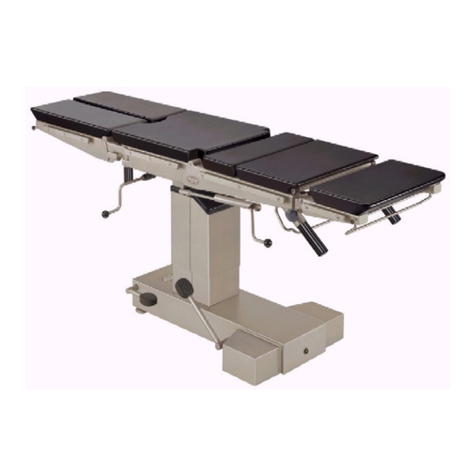
User manual for Operating table SU-14
Page 7
1. Proper use and application
1.1 Use
Operating table SU-14 is designed for supporting the patient during carrying out treatments and
operations. The table with the proper accessories can be used for treatments and operations in the
range of general surgery, vascular surgery, cardio surgery, neurosurgery, urology, proctology,
gynecology, laryngological, ophthalmology, endoscopies, laparoscopy, traumatic, oncology, dental,
plastic surgery and others. Table top segments are X-ray permeable.
1.2 General requirements
The product is intended to be used indoors. Required climatic conditions: temperature from +10 to
+45ºC, acceptable change of surrounding temperature during 8 hours should not exceed 20°C,
relative humidity of the air should range from 30 to 80%, atmospheric pressure from 700 to 1060 hPa.
The product should be used, maintained and serviced according to the instructions contained in this
manual.
Caution!
Using, maintaining and servicing the product in other way than indicated in this
manual is not permitted and may lead to damages for which the user is to blame
and for which the producer is not responsible.
Installation of other accessories than those offered by the producer for the
product is allowed only on the basis of a written acceptance of the producer.
1.3 Duties of the user
User: any individual or corporate body who uses the product as its owner, lessee, pledge or who has
a different right to the product as well as an entity who uses the product on its own or on whose behalf
it is used.
The user must ensure that the product shall be used exclusively in conformity with its destination and
that it is used in appropriate conditions and in consistence with this manual. The user is also obliged to
take all necessary precautions in order to prevent all life and health hazards concerning the user,
patients and any third party. Only authorised persons who underwent special training and are
acquainted with this manual may operate the product. The user must also ensure that all persons who
operate the product have read, understood and apply instructions contained in this manual.
1.4 Description of product
The operating table consist of table base and table top that are permanently connection.
In standard version the table has a mobile base , equipped with central blockade, which is released
with a foot lever.
The table-top consists of segments, which number and configuration has constants number and
configuration (according to a customer special order this number will be change). Segments of table
top are X-ray permeable. The table top is provided with polyurethane mattresses. On both sides of the
top there are side strips which allow installing accessories.
Change of the angle of table top segments as well as movement of the column are adjusted by
mechanic electro-mechanics systems. In standard version the electric and electromagnetic
movements of table can be controlled by wire-connected controller.
Thanks to the wide range of offered accessories the table can be used for different types of operations
according to client wish. List of accessories you can find in Paragraph 4 - Installation and operation of
accessories.
The main power outlet is connected to the table by the power cord. In order to disconnect, the user
must unplug the power cord from the main power outlet.
The producer reserves the right to introduce in the product structural modifications resulting
from technical progress which are not covered in this user manual.
The producer reserves that all parameters and accessories can be modified or change,
especially construction, technology and materials, not lowering accepted parameter
technically - user and safeties of products.




























